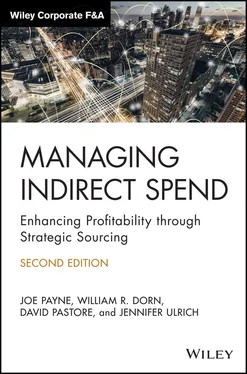1 ...8 9 10 12 13 14 ...20 1 Business relationship: Understand the initiation, selection criteria used, progression, value, and the short‐ and long‐term direction of the business partnership with the supplier.
2 Product or service: Understand your company's need, use, and application of the product or service being purchased.
3 Locations: Obtain a list of all locations that use this product or service and understand how the supplier's product or service is used in each location, particularly regarding similarities and differences and their ensuing impact.
4 Financial: Understand all costs related to the product or service. These include history of price changes, reasons for discounts, payment terms, who negotiates and when, annual volume, and current and future volume usage.
5 Contractual: Understand the contract terms and language, reason for existence or nonexistence, history, changes since signing, and reasons for such changes.
6 Reports: View and understand the various reports produced (by the supplier as well as internally) to track costs and performance.
7 Service: Understand service standards, expectations and measurement used, service process, level of customer satisfaction, and company satisfaction.
8 Supplier Ranking: Ask the end user to rank the supplier according to commitment to the quality of the product or service, value of the partnership, accuracy, creativity, responsiveness, and assistance.
Defining Roles and Responsibilities
The last component to focus on when engaging end users is defining roles and responsibilities. Providing a consistent message to the supply base (both incumbents and alternate suppliers) is critical to ensuring a positive end result. A supplier who hears different things from different members of your team may either disengage from the process or provide a proposal that factors in uncertainty. For this reason, it is essential to assign a project lead. This person (who may be an end user) should be the primary point person that suppliers go to when asking questions, requesting clarification, or providing input. This primary point of contact is also responsible for collecting information and providing your requirements to suppliers throughout a sourcing engagement.
This arrangement does not imply that the rest of the team should be disengaged from the process. By all means, the team should work together to develop the strategy, build requirements, identify alternates, create documents, review proposals, and develop responses to supplier questions. But to ensure consistent messaging, all that information should be provided to the supplier base through a primary point person.
As you move to later phases in the initiative (such as finalist presentations, negotiations, award, and implementation), more members of the team become engaged, at which point it makes sense to have members of your team work directly with members of the supplier's team. But as a starting point, designating a primary point person to provide your requirements to the supplier community helps to avoid a large amount of confusion and miscommunication.
LINE‐ITEM DETAIL AND GETTING THE MOST FROM YOUR SUPPLY BASE
End users can provide you with a good understanding of supplier relationships and history, service levels, and other critical aspects of the requirements of the product or service being purchased. You may have even collected some information you did not have before, including contracts or purchasing agreements, specifications and forecasts, or other reports that end users have available. This information is a necessary part of the analysis process, but the most critical piece is probably still missing—line‐item detail of purchases. Looking at your AP or purchase order (PO) data probably does not help. The descriptions in that data are likely to be as inconsistent as the supplier name and transactions at the invoice level. If you have a good inventory requisition system or have implemented a procure‐to‐pay system, you are starting off in a better position than most, but the system may not include all the data you need beyond unit price, such as freight, terms, and additional charges.
You can collect the data that resides within your organization by pulling invoices and manually entering the information into a spreadsheet. Depending on the category and the level of centralization within your organization, this can be a very tedious process and, without an army of interns at your disposal, could extend the sourcing timeline substantially.
The most efficient way to gather the requisite line‐item detail is to request reporting from your suppliers directly. While most companies do not keep good records of the items they buy (particularly for nonproduction purchases) all organizations keep excellent records of what was sold.
Almost all of your suppliers have line‐item details for everything they have sold to your organization and can provide reports in spreadsheet format detailing those purchases. Some, however, are naturally reluctant to do so. Suppliers understand that a customer looking for data of this nature is typically seeking to reduce prices, either through a one‐off negotiation or as part of a bidding and sourcing process. With that in mind, you should consider this request for information as the first step in negotiations with your incumbent supplier. Be prepared for one of three responses to your request: acceptance, avoidance, or pushback.
Depending on the category you are sourcing and the quality of the relationship that exists with that supplier, often a request for historical sales information is perceived as business as usual or even an opportunity to partner more closely with your company. The supplier gladly gives you the information you need and even follows up to make sure you understand the data. This is the ideal response.
It is often possible to confuse the avoidance response with the acceptance response. A supplier may initially appear agreeable to meeting your request. Weeks later, however, you may realize that you have not received a response. Once the data do eventually arrive, they could be incomplete or not comply with the level of detail the supplier committed to. If the sales representative seems to be saying all the right things but ultimately can't deliver what you have requested, the supplier is using the avoidance response. You can take several steps at this point.
First, when making the request for data, provide a template that shows the level of detail you are looking for. Review the template with the supplier and make sure the representative understands what the template means and agrees it can be populated. Then agree to a due date for completion.
As the due date gets closer, follow up with the supplier and ask for a status update on the reports. If your sales representative appears unsure of the status (or does not appear optimistic about the outcome), request to speak directly to the IT contact responsible for creating the report. This demonstrates that you are serious about your request. It can often help overcome the supplier's stall tactics or help the supplier overcome other challenges, such as time constraints or other priorities (e.g. selling to other customers) if they do legitimately intend to come through on your request.
Sometimes, a supplier flat‐out refuses to provide a line‐item detail report. This is typically the exception and not the rule, but when this issue does arise, it is important to understand why.
First, the sales representative might not know how to get the reports you need. An inexperienced individual may decide to tell you the reports are not available. Alternatively, they may try to find out how to get them, fail, and then give up. Other representatives may tell you that a report is unavailable in hopes that you will give up the pursuit. For this reason, it is helpful to hold onto any reports you receive when you finally do get them for the supplier's reference the next time you need to make such a request.
Читать дальше












